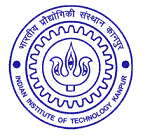Rapid Prototyping
Prototyping is an essential part of the design process. It exposes and facilitates the elimination of design errors early in the product development stage and before any significant investment is made. Rapid Prototyping (RP), physical parts are fabricated layer by layer. It uses additive manufacturing processes, which do not require any tools or set-ups compared to the subtractive techniques used in the traditional machining operation and thus reduces the prototype development time.
The main RP source at IIT Kanpur is a Fused Deposition Modeling system (FDM) RP system at Computer Aided Design Lab (CAD Lab) a central facility of the institution. The system is Stratasys FDM 1650, equipped for prototyping with ABS plastic. Another RP machine in the lab is a Solid Ground Curing (SGC) system. The system is Cubital Solider 5600 and is an industry class machine.
Stratasys Facility Fused Deposition Modeling or FDM is a process which deposits a continuous filament of a thermoplastic polymer through a resistively heated nozzle, the material is delivered as a wire in to the extrusion head and heated to slightly above its flow point, so that it solidifies relatively quickly after it exits the nozzle.
Specification:
Build Size
|
Models up to 254*254*254 mm (10*10*10 inch) can be built
|
Achievable Accuracy
|
From CAD data : + 0.30" ( + .762 mm)
|
Modeling Materials
|
ABS white ( Acrylonitrile Butadiene Styrene ), MABS ( Methly Methacrylate ABS ), WAX
|
Layer Width/Thickness
|
Operator may optionally select road widths between .254to2.54 mm (.010 to .100 inch) and thickness from .05 to.762 mm (.002 to.030 inch)
|
Compatibility
|
Windows NT, Silicon Graphics, Sun Microsystems, HP
|
Support Structures
|
Automatically generated with support works software or similar; Break-Away Support System allows support removal
|
Cubital Facility
In this process what is known as SGC or Solid Ground Curing, an entire cross-section is imaged in a single operation using photo mask. Some of the advantages of this process (from manufacturers catalogue) are as follows :
Build time is independent of the number of slots being made at a time. Therefore, it can act as a production machine.
- No external support structure is required.
- Accuracy of the part is good.
- No warping or curling of the part takes place.
- Large variety of photopolymers can be used for building the parts.
Specification:
Build Size
|
Models up to 500*350*500 mm (20*14*20 inch) can be built
|
Achievable Accuracy
|
0.1% (Measured between targets through the material)
|
X-Y Resolution
|
0.084 mm (0.0033 inch)
|
Z Resolution (Variable Layer Thickness)
|
0.1 - 0.2 mm (0.004 - 0.008 inch)
|
Projects
Several number of projects from HAL, Ministry of Defense, ADA, BHEL, MARUTI, TELCO, TISCO, LML and for others have been completed successfully using RE, RT, RP methodology. We have successfully made prototypes for large and intricate parts for these industries, with excellent surface finish and tolerance. It shows our expertise and commitment to bring this new technology in the country. We have done a great deal of work in the area of footwear and tannery industries. These industries are responsible for exporting large quantities of footwear every year. The industry always looks for a new design and concept to keep it competent in world market.
Running project :
Development of saddletrees : Saddletrees are traditionally hand made in India with various wooden elements in it. The traditional manufacturing lacks in strength, symmetry, standardization and accuracy and its time to market is long. The motive behind this work was to use reverse engineering (RE) and rapid prototyping (RP) and latest CAD-CAM technology, to help the artisans in the development process of a saddle.
Working of FDM Machine
Press play button
All Rights Reserved By: CAD LAB Indian Institute of Technology, Kanpur - INDIA
[This Website is designed & maintained by: Dr. A. Chatterjee]













